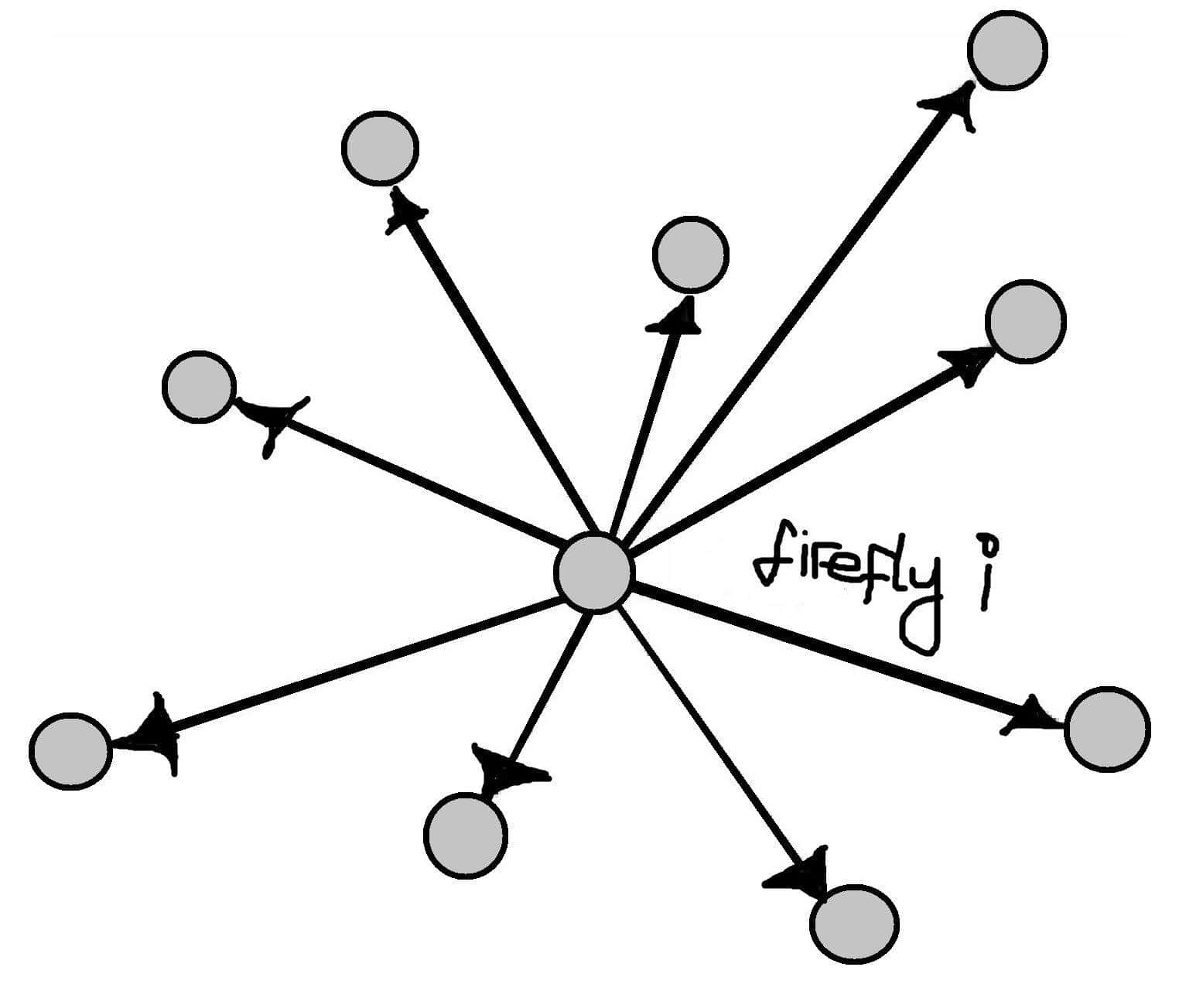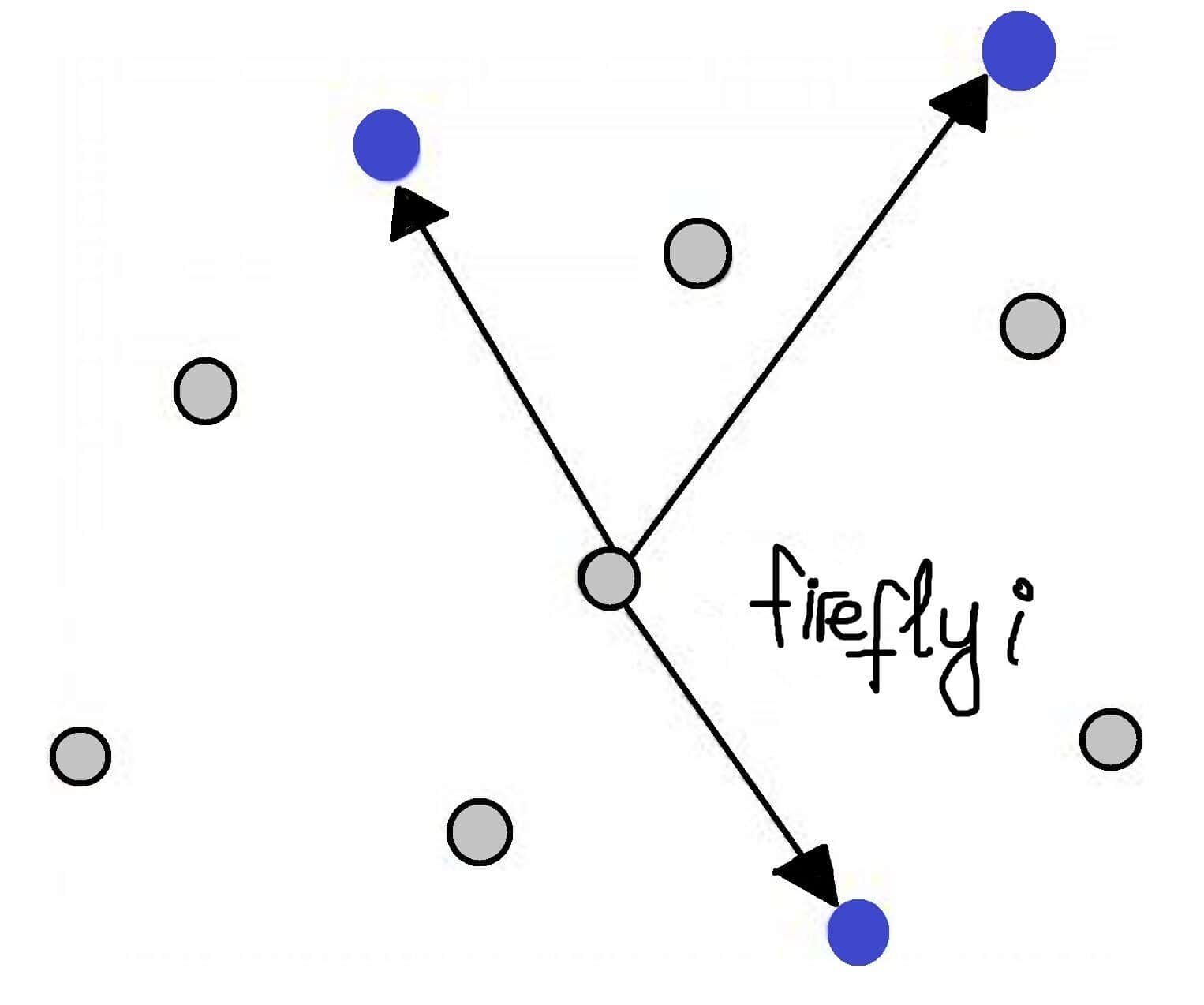1. 概述
在本教程中,我们将学习元启发式算法(Metaheuristics)中的一个经典算法——萤火虫算法(Firefly Algorithm)。在此之前,我们先快速回顾一下元启发式算法的基本概念。
2. 元启发式算法简介
元启发式(Metaheuristics)与启发式(Heuristics)类似,都是用于寻找问题的潜在最优解。不同之处在于,元启发式算法具有通用性,适用于多种优化问题。
与启发式算法一样,元启发式算法也具有“无法精确衡量解的质量”和“执行效率合理”的特点。但与启发式不同的是,元启发式算法采用的是与问题无关的设计原则。✅
通常情况下,元启发式算法是为全局优化问题而设计的。
3. 萤火虫算法
本节分为三个小节,首先介绍萤火虫算法的基本信息,接着讲解其实现步骤,最后提供伪代码实现。
3.1. 基本信息
萤火虫算法是一种受自然界萤火虫群体行为启发的元启发式优化算法。它模拟了萤火虫之间通过光亮吸引彼此的行为,用于求解复杂的优化问题。
该算法由剑桥大学的杨新社博士于2007年提出。它是群智能优化算法(Swarm Intelligence)的一种,与粒子群优化(PSO)、人工蜂群优化(ABC)、细菌觅食优化等算法有很多相似之处。✅
萤火虫算法使用真实随机数,其粒子具有全局通信能力。在多目标优化方面,萤火虫算法表现出较强的适应性和效率。
3.2. 算法步骤
萤火虫算法基于真实萤火虫的发光行为,遵循以下三条规则:
- 所有萤火虫不分性别,个体之间可以相互吸引。
- 萤火虫的吸引力与其亮度成正比,距离越远吸引力越弱(光在空气中会衰减)。
- 如果没有比某只萤火虫更亮的个体,它会随机移动。
下图展示了萤火虫之间的吸引与移动关系:


萤火虫的亮度由目标函数的值决定,即亮度越高,对应的目标函数值越优。
3.3. 代码实现
了解了萤火虫算法的基本原理后,我们可以用伪代码来表示其核心逻辑:
algorithm FireflyAlgorithm:
// INPUT
// f = 目标函数
// OUTPUT
// 找到优化 f 的最优解
随机生成 n 个萤火虫的初始种群
计算每个萤火虫的适应度(亮度)
while 满足终止条件之前:
for i <- 1 到 N:
for j <- 1 到 N:
if y_i 的适应度 > y_j 的适应度:
// y_i 比 y_j 更亮
将 y_i 向 y_j 移动
根据萤火虫之间的距离 r 调整吸引力
对萤火虫排序并更新全局最优解
萤火虫算法已有多种语言实现,例如 Matlab 和 Python。
4. 应用场景
萤火虫算法在多个领域都有实际应用,以下是一些典型使用场景:
- ✅ 图像压缩与图像处理:用于解决图像压缩中的局部最优问题。
- ✅ 特征选择与故障检测:在分类和回归模型中选择最优特征,辅助决策。
- ✅ 天线设计:优化天线阵列布局。
- ✅ 结构设计:用于建筑结构的最优设计。
- ✅ 任务调度:解决调度问题中的最优安排。
- ✅ 语义网服务组合:在语义网服务中寻找最优组合。
- ✅ 化学相平衡建模:用于化学反应中活性系数的建模。
- ✅ 生物医学与医疗健康:如乳腺癌分类、视网膜图像分析、脑肿瘤检测、健康监测等。
- ✅ 聚类分析:确定最优聚类数,提升聚类效果。
- ✅ 刚性图像配准:作为优化工具,用于自动目标识别和图像配准。
5. 总结
本文介绍了元启发式优化算法中的一种——萤火虫算法。我们首先回顾了元启发式算法的基本概念,接着详细讲解了萤火虫算法的原理、实现步骤及其伪代码表示。
最后,我们列举了该算法在多个领域的应用,展示了其广泛适用性和强大的优化能力。萤火虫算法在处理多目标优化问题时尤其具有优势,是一种值得深入研究和使用的智能优化方法。✅